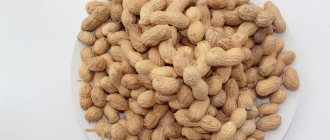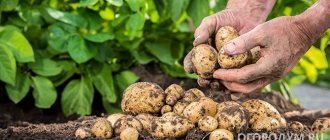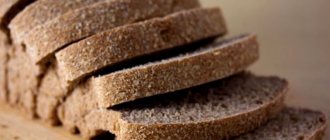Nuts, including hazelnuts, as a source of vegetable proteins and fats, are consumed as an additive to the main diet or as a component of various dishes. A soft, delicate nutty note complements and enhances their aroma, making it original and memorable. Lovers of healthy fruits know that their proper preparation and storage are of no small importance in preserving the natural taste. Where and how to store hazelnuts at home, whether to peel them or not – these are the points that raise the most questions.
How to preserve fruits in shell and without it
The conditions under which peeled and unshelled nuts must be stored are different.
In a shell
Unshelled nuts after drying are sent to a dry cellar, cool pantry, or other utility room, the humidity of which does not exceed 70%. The most suitable temperature range is from 5 to 20˚С above zero.
Residents of city apartments that do not have a basement can store walnuts in shell in boxes or bags that are well-ventilated. Keep them on the balcony in a place where precipitation and sunlight do not fall.
If there is no glazed balcony, put the fruits in a closet, pantry or refrigerator.
The shelf life of inshell walnuts depends on whether you comply with the temperature and humidity requirements. In a room with appropriate conditions, it will remain fresh and edible for 1.5-2 years.
Without shell
Cleaned grains deteriorate much faster than in shells. To keep them longer, use the following methods:
In an airtight container. Store grains that have been pre-sterilized by freezing or roasting in jars, plastic containers or vacuum packages. The product should be kept in a dry, dark place. With this method, it retains its pleasant taste and beneficial properties for about 3-4 months. Kernels that have not been pre-treated can remain in a tin or glass container for no more than 1 month. Moisture and pests do not penetrate into closed jars.
- In the freezer. It is recommended to store shelled walnuts at home at a low temperature. To do this, fill a vacuum container with kernels and place it in the freezer. With this method, the kernels remain fresh for 1 year.
- Cold sterilization. If you have a lot of shelled grains for which there is not enough free space in the freezer, you can temporarily freeze them. To do this, small batches are frozen one at a time for 2-3 days, and then sent for storage in a closet or pantry. This method helps to destroy pests and their larvae, which thrive at room temperatures and quickly die in the cold.
- Calcination in the oven. The sterilization procedure in order to suppress the vital activity of bacteria and insects can also be carried out by calcination in the oven for 5-10 minutes. This method will also remove excess moisture from the fruit, which is the main cause of rancidity and mold. Lightly fry a small amount of nuts in a wide frying pan. Pine nuts can be processed in the same way.
If you notice that the grains in the shell are starting to deteriorate, then fry them in the oven.
Then peel, put into vacuum bags and put in the freezer. In this case, all damaged kernels must be thrown away.
Conditions for long-term preservation
Many housewives like to buy food in reserve. In this regard, it is necessary to take care of proper storage.
The table shows the shelf life of nuts at home depending on temperature.
| At room temperature | In a refrigerator | In the freezer | |
| Brazilian nut | More than a year in sealed packaging | No more than a month in an airtight container | A few months |
| Hazelnut | Up to 3 months | In shell - up to 9 months, peeled - 6 months. | 1 year or more |
| Cashew | About a month | Up to two months | Up to 6 months |
| Almond | A few months | Up to 6 months | Up to 1 year |
Can it be stored in the freezer?
For longer storage, nuts can be placed in the freezer. To do this, they are placed in a glass or plastic container with a tight-fitting lid . You can store it in a bag, but foreign odors can leak through it, and the kernels quickly absorb them.
The duration of storage in the freezer depends on the variety and ranges from several months to several years.
Is it necessary to fry, dry shelled nuts and why do they do it?
Nut kernels contain oils and moisture . A humid environment can lead to mold and pathogens. And oils, when exposed to oxygen, lose their properties, acquire a bitter taste and can even become dangerous to human health. You can dry the nuts in the fresh air, in the oven, in the microwave or in a dryer.
Storing Unshelled Nuts
It is recommended to store hazelnuts in shell in order to protect the kernels from external factors. And also increase the shelf life of the product.
- Unshelled hazelnuts are best stored in canvas bags. However, the use of synthetic fabric and polyethylene is not recommended. The product will not be able to “breathe” and will quickly begin to become moldy.
- A place for storing nuts in shell should be chosen with a low level of humidity and low temperature. A prerequisite is the absence of sunlight.
- Air humidity at 12 - 14%, and a temperature of +3°C -+12°C can ensure the storage of unpeeled hazelnuts for 12 months. A lower temperature (0°C -+3°C) will allow hazelnuts to be stored for several years.
- During storage, avoid proximity to products and substances that have a strong odor. Due to their porous structure, hazelnuts quickly absorb the aromas of the environment, which greatly affects its quality.
The shelf life of unshelled hazelnuts in the refrigerator is about 12 months. And when frozen, it will retain its original properties for 3 years.
How to prepare hazelnuts for storage
Even a small bush can produce a good harvest of nuts. If you store hazelnuts correctly, you can be provided with this product all year round. But it is important to properly prepare the fruits for storage.
The hazelnut ripening period is August - September. You can determine that the fruits have reached full maturity by the brown color of their shells and falling to the ground when the branches are slightly shaken.
The crop should be harvested immediately after it ripens. Delay in this matter may lead to birds and rodents taking over the collection. After all, they have long appreciated this nut.
After the fruits are collected, they are sorted, removing damaged nuts and various debris. After which the remaining harvest is sent for drying.
Hazelnuts should be dried in places with good lighting and ventilation. This usually takes several days. The fruits should be well dried to ensure long-term storage. Therefore, such a procedure is mandatory.
You can tell that the nuts are ripe and well dried by the sound they make when poured. The sound should be ringing and clicking. And the kernel inside the shell should not knock against the walls.
You should not over-dry the nuts. Therefore, their condition during drying should be checked more often. To do this, the shell is cracked and the degree of drying of the kernel is determined.
Hazelnuts should be stored in their shells. Cleaned kernels will not retain their original quality for long.
The condition of the crop should be checked every 1 - 2 months to identify those fruits that have begun to deteriorate.
Storing grain for germination
If the grain is intended for germination, it cannot be processed at high temperatures (hot steam, frying, oven drying). This treatment can increase the shelf life of wheat grains, but at the same time they will lose the substances necessary for germination.
Grain that has not been subjected to heat treatment retains all the beneficial substances that nature has put into it. At the moment of germination, it contains the largest amount of vitamins and nutrients. Therefore, people who care about their health use wheat germ as a dietary supplement. They also make salads and other dishes based on it.
Storing sprouted wheat
At the moment of germination, wheat has medicinal properties to a greater extent than other grains. But for the effect of consuming sprouted grains to become noticeable, they should be consumed for a long time. Therefore, the question of how to store sprouted wheat interests many.
To get a portion of sprouted grain, you should soak 2 - 3 tablespoons of wheat and leave until it germinates. It should be consumed fresh, but if some part remains unused, it is sent to the refrigerator.
The shelf life of sprouted wheat in the refrigerator does not exceed 2 - 3 days. There is no point in leaving it longer, because after 3 days it will lose most of its beneficial properties.
If you create normal conditions for storing wheat and protect it from pests, the reserves will remain usable for a very long time.
Preparation of raw materials for storage
Even from a small nut bush you can reap a good harvest, which will last until next year, but provided that it is properly stored and, which is also very important, the fruits are properly prepared for storage.
The ripening of hazelnuts (August-September) is indicated by the brown color of the shell and the shedding of fruits when the branches are shaken. Collection should be carried out as quickly as possible, because birds and rodents like the delicacy.
The harvested crop must be carefully inspected, debris and damaged fruits must be removed and laid out to dry in a place where it is dry, light and there is access to fresh air.
The next stage of drying, after repeated inspection, is carried out in a dark place. During this time, the kernels will acquire a typical texture, the taste will become more intense, and the concentration of nutrients will reach a maximum.
You can check whether the kernel is fully ripe by sound - when pouring, the shell of a mature, high-quality nut makes a loud clicking sound, but the kernel inside does not knock. In order not to miss the moment of complete drying, you need to periodically check the readiness of the shell and kernel, i.e. just crack the nut.
How to store peeled hazelnuts at home
Experts recommend peeling hazelnuts no earlier than an hour before eating. This is explained by the fact that the kernels have the ability to quickly absorb extraneous aromas and moisture, which negatively affects their quality. If the nuts have already been peeled, then they are sent for storage in a dry, tightly closed ceramic or glass container.
It is recommended to store peeled hazelnuts at a temperature of +3 ... +10 ° C and air humidity of 10-15%. Such conditions are considered optimal and ensure a shelf life of the finished product of 4-5 months. The longer shelled hazelnuts are stored, the greater the likelihood that they may go rancid, so it is recommended to consume the nuts as soon as possible.
How long and under what conditions can nuts be stored?
Shelf life depends on many factors . The type of nuts is taken into account, whether they are in shell or not, and the conditions in the room.
How to store Brazil nuts
The king of nuts is considered to be Brazillian, or Bertoletia . It is a fruit with a diameter of 15 cm and weighing up to 2 kg. Inside it are from 8 to 24 kernels of nuts.
Brazil nuts are rich in vitamins E, C, D, group B and minerals: phosphorus, iron, copper, potassium, manganese, selenium, zinc. It will be an alternative source of protein for vegetarians: it contains a large amount of amino acids and healthy fats.
Advice. When buying a Bertoletia in a store, shake it and listen to the sound. If the sound is rattling, it means the nuts inside are empty. It is not worth buying such a fruit. A high-quality walnut does not make any sounds.
also find shelled Bertoletia in the store , but it is worth considering that peeled kernels tend to absorb foreign odors.
Place Bertoletia for storage in a room with low humidity, without sources of heat and sunlight. Storage temperature – +2…+8°С.
About storing other products:
How to store hazelnuts
Hazelnuts are brown fruits in the shell, slightly elongated in shape . It contains vitamins B1, B2, B6, E, as well as micro- and macroelements - iron, sodium, potassium, calcium, magnesium, phosphorus, zinc.
It is useful to eat to reduce the likelihood of cancer and Alzheimer's disease, as well as for people suffering from diabetes. Eating hazelnuts increases mental activity and reduces the intensity of putrefactive processes in the intestines.
When choosing hazelnuts in a store, pay attention to the shell . It should be free of cracks and chips. The smell should not be musty, and the sound should be clear.
Important! It is better to store hazelnuts in the shell, since unshelled kernels do not last long.
Hazelnuts in shell are placed in a dry place with an air temperature of 0...+3°C.
Peeled hazelnut kernels are stored in glass or ceramic containers that can be tightly closed. Storage temperature is +3…+10°С.
How to store cashew nuts
Cashew consists of two parts . The upper part is a juicy fruit, and the lower part is a nut.
How to peel peanuts, almonds and pine nuts, including removing the husks
Peanuts are easy to peel after roasting in the oven for 3–5 minutes at 180°C. After this, the nuts are placed in a bag and “rolled” on the table with your hand or a rolling pin until the husks are completely destroyed. Peeled and dried fruits are poured into a sieve and rubbed with your hands until the crushed brown film pours out through the holes. If the peanuts were peeled raw, then the nuts are filled with water for several hours and freed from the film with your fingers.
Almonds and pine nuts are placed in boiling water for 1-2 minutes and then peeled in the same way as peanuts.
Knowing how to select, clean and store nuts, you can enjoy their taste all year round!
Where does hazel grow and how to collect it?
Proper collection of raw materials allows you to preserve the healing properties of hazel. Do not collect near the road, in dusty or densely populated areas. To harvest, you need to go to the forest. Grows in oak, coniferous-deciduous, coniferous alpine forests.
For medicinal purposes, all parts of hazel are harvested: bark, fruits, leaves, roots. The procedure for collecting and preparing hazel:
- In early spring, before the buds open, the bark is harvested. It is removed from branches that can be trimmed with a knife. Drying takes a long time. A sign that the bark is ready is its characteristic fragility. Harvesting is allowed in the fall.
- The fruits are harvested in early September after they acquire a light brown hue and are easily separated from the branches. Several nuts are picked in shells at once. The fruits are laid to dry, during which the plus disappears. After this, the nuts are sorted, damaged and wormy ones are removed, and the shell is peeled. Final drying is done in the sun, in an oven or in an electric dryer.
- Young leaves and catkins are harvested in early May in dry weather. The leaves can be collected throughout the summer, but in the spring they contain the most complete range of useful substances. If it rains, wait a few days.
Collect leaves separately from catkins. At home, additionally sort and place to dry in a dark, dry room, preferably in a draft. A shed, an attic are suitable, you can simply spread it on paper or a sheet on the floor of a non-residential room.
To preserve raw materials, paper or fabric bags and cardboard boxes are used. It is allowed to use glass containers, but with air access; to do this, tie the top of the jar with gauze. The shelf life of raw materials is 1-2 years.
How long can you store?
It is known that at room temperature, peeled hazelnuts retain their qualities and beneficial properties for up to 2 weeks. In a refrigerator or dry basement, this period increases to 3-4 months, and in a freezer - up to six months.
It is worth noting that the shelf life of hazelnuts is largely determined by the chosen form of storage. In the shell, this period is significantly extended, but peeled nuts quickly lose their taste characteristics and absorb third-party aromas and moisture. If peeled hazelnuts are stored in the refrigerator for only 5-6 months, then in shell this time extends to 9-12 months.
If even small spots of mold were noticed on the nuts, this indicates that they are unsuitable for consumption. Even if you quickly get rid of the mold, the harmful substances will already have time to penetrate deep into the structure of the nut kernel and you can easily become poisoned by such a product. In addition, it will have an unpleasant bitter taste.
You cannot store hazelnuts from different harvests or batches in the same package, and even more so, it is forbidden to mix them with other types of nuts. Do not store hazelnuts in open containers, since the kernels quickly become bitter and gain moisture. Also, a young nut that has not had time to ripen on the tree is not suitable for planting.
A sign of hazelnut quality is a fresh, classic smell. As soon as notes of bitterness or mold begin to be felt in it, then you can no longer eat such nuts. Due to violations of storage conditions, the product loses most of its beneficial components and nutrients, so you must carefully follow all recommendations and not deviate from them. Only in this case can you be sure of the quality and safety of the stored harvest.
Roasted hazelnuts have a short shelf life. If all necessary conditions are met and the temperature is maintained at +3...+12 °C, this period does not exceed 3 months, so it is recommended to cook it in small portions.
Reviews
Galina, Ivanovo
I don’t grow nuts in my dacha, but every year my relatives bring us a lot of hazelnuts. I store most of it in a shell in a closet, putting it in a basket and drying it before, I clean the rest. I use the peeled ones in dishes, eat them just like that, fry some of them in the oven and store them in the refrigerator. The rest, not fried, I use when making jam (they give a pleasant taste and aroma) or I chop and mix with honey and store in the refrigerator. This way I have all my nuts in hand and nothing goes to waste.
Svetlana Sergeevna, Gomel
We have one hazelnut bush growing at our dacha, but the harvest lasts from season to season. I dry the collected nuts well on the veranda until the shells become hard and durable and store them in small wooden boxes or baskets on racks in a warm, ventilated basement. One year I put it in the cellar, but the kernels had a damp smell, and in some boxes they were covered with mold. It’s convenient to take it out of the basement in small batches and do whatever you want, and it’s more convenient to clean small batches. I like to make kozinaki with honey from nuts; I add them to various breadings, sauces, and salads.
In conclusion, we can say that following simple rules for selecting and storing raw materials significantly extends the life of nuts while maintaining their taste and quality.
Hazelnuts are usually considered as an integral part of many dishes, more often desserts. Due to its high content of nutrients (vitamins, vegetable fats), it can easily compete with other types of nuts. Today we’ll talk about how to properly store hazelnuts at home, and how to choose them correctly.
General features of cleaning and storing nuts
The quality and freshness of nut kernels depends on storage conditions and whether they are peeled or not. They last much longer in the shell, so it is preferable to buy unpeeled fruits.
What you should pay attention to when buying nuts in any form:
- The shell should be smooth, without stains, cracks or holes.
- The kernel should not “knock” much inside the shell when shaken. Only overdried or old fruits make this sound.
- Nuts that have been cleaned should be free of plaque and traces of mold.
- The smell should be pleasant, “nutty”. If there is an unpleasant or foreign odor, it is better to refuse the purchase.
In order for the kernels not to lose their taste and nutritional qualities, you need to know how and where to store them. Each type has its own expiration date. If nutmeg does not lose its properties for 3–9 years, then pine nuts begin to deteriorate after 1–2 months. The degree of maturity is of great importance. Only ripe and well-dried fruits are suitable for long-term storage.
Photo gallery: types of nuts
The shell of the Manchurian nut is more wrinkled than the shell of a walnut Black walnut is another close relative of the more popular walnut Hazelnut is deservedly called the royal nut Brazil nut from start to finish peeling Cashews are nuts that do not need to be peeled Chestnuts are a favorite delicacy of the French Pistachio is a nut that “smiles” Pine nuts are an expensive but valuable product
Selecting raw materials for storage
In whatever form you store nuts (shelled or not), in any case, the very first stage is the procurement of raw materials.
How to choose:
- pay attention to the condition of the shell - clean, dry, without damage, stains or mold;
- if you hear a knock when shaking, it means the fruit is old and the core has dried out;
- absence of foreign odors from nuts;
- when purchased in a store, the shelf life should not be expired;
- kernels without shells should be light, clean, without unnecessary odors and traces of the presence of insects;
- ask to taste the product - the presence of bitterness indicates a violation of storage conditions.
It turns out that hazelnuts can sound! If a handful of unshelled nuts is poured onto a hard surface, the fresh ones will make a ringing sound, while the old ones will sound dull.
Choosing nuts for storage
Fruits of the highest and first quality grades have the ability to preserve nutritional properties for a long time. They are distinguished by the following characteristics:
- the shells are thin, tightly adjacent to each other;
- the ribs on the surface are weakly expressed, slightly rough;
- the kernels are freely separated into halves and quarters and do not crumble;
- The nut is heavy and does not ring when shaken;
- subtle specific smell.
When shelled, they should be firm, light gray to light brown in color. Blackness and wrinkling of the shell mean that the product is expired or storage conditions have been violated.
Storing walnuts in a jar or box
Fine:
- the amniotic rind is absent;
- smooth, symmetrical shape;
- round fruit size from 2.5 cm and above;
- nuts drown in water.
Badly:
- bright yellow color of the shell or kernel;
- the shell is cracked with your fingers;
- the kernel shriveled and shriveled;
- there are signs of pest infestation.
When the nut is less than 2 cm in length and irregular in shape, it is a substandard product. If you pull the halves in different directions and a gap between them becomes visible, the harvest was harvested too early or from diseased trees. They will not be stored due to free access of air to the core.
If the nuts do not smell of anything, they are unripe, and if they emit a rancid smell with a hint of mold, they are rotten or have expired. Green nuts do not have the ability to ripen like kiwi at home and spoil within a week.
Common hazel: description, photo
Hazel (hazel) is a deciduous shrub of the birch family with a powerful root system, lush crown, up to 3-7 meters in height. It has many shoots covered with bark with transverse patterns. The plant got its name because of the shape of the leaves; they are believed to resemble bream fish.
They are large, rough, and light green in color. In autumn the leaves turn red or yellow. The edges of the leaf blade are jagged, so the leaves have an attractive appearance.
In spring, hazel is covered with long earrings (up to 7 cm), single or in clusters of 2-3 pieces. These are male flowers, they appear on the bushes in the fall, after winter they bloom before the foliage appears. The female flowers resemble buds.
Hazel can live up to 100 years. Fruiting begins at the age of 8. Hazelnut (hazelnut) is widely popular due to its taste and benefits for the body. The nuts ripen in the fall. They are light brown in color, wrapped in a light green plush. Hazel grows in Europe, Transcaucasia, and Ukraine.
Requirements for choosing hazelnuts
Hazelnuts are grown both for personal consumption and for profit. The choice of variety depends on the final goal
As a rule, gardeners give preference to frost-resistant or drought-resistant varieties, and only then pay attention to the characteristics of their fruits
In varieties with round fruits, the kernels are mainly stored, since when they are split, minimal debris is formed. Nuts contain a lot of vegetable fats and proteins. Varieties with a cone-shaped fruit are usually stored together with the shell. Varieties with oval-shaped nuts are almost never subjected to industrial processing, and at home they are stored in their shells.
We buy hazelnuts
To choose high-quality fruits, you need to pay attention to whether they lack:
- mold;
- rancid smell;
- cracks;
- traces of damage caused by insects (holey shell, dark surface).
Good fruits are quite heavy. You can also check their quality by sound. You just need to take a handful and then pour it out. If a ringing sound is produced when you hit the surface, it means that everything is fine with the hazelnuts and you can buy them for future use.
Store in shell
These nuts should only be stored in a room where low humidity and temperature will be maintained. The product should not be exposed to direct sunlight. Unshelled, these nuts can be successfully preserved by placing them in thick fabric bags. But such products should not be stored in plastic and other bags that do not allow air to pass through. Mold will soon form on them. After this, hazelnuts will under no circumstances be consumed. Mold has a harmful effect on it, which can lead to severe poisoning and other problems. Make sure that no products with a strong odor are stored near hazelnuts. In addition, hazelnuts can be frozen. In this condition it will be suitable for use for 3 years. If you put it on the top shelves of the refrigerator, you can keep the product fresh for a year
But it is important to ensure that the hazelnuts are not affected by sudden changes in temperature.
Storage tips
Even small spots of mold indicate that the nuts are hopelessly spoiled and are not suitable for consumption. You can also tell that a product is spoiled by its bitter taste.
The specific fresh nutty aroma is an indicator of the quality of the product. But as soon as notes of bitterness appear, such a product can no longer be eaten.
Storing hazelnuts from different batches in the same container is not recommended. And it is even more undesirable to mix it with other types of nuts.
After opening the factory packaging of nuts, they should be poured into a glass container and closed tightly. You should not store hazelnuts in open manufacturer's packaging, as they will quickly become bitter.
Nuts contain many substances necessary for the human body. But as a result of improper storage, this product loses most of them. Therefore, it is very important to store hazelnuts correctly to always be sure of their quality.
How to preserve walnuts at home
Walnuts are very rich in fats. When exposed to heat, they split, resulting in a rancid smell and taste.
It is important to know how to store nuts at home to prevent this from happening.
For long-term storage, it is not recommended to purchase peeled ones. It is better to buy it in shell and remove it yourself. Then there will be exact confidence in the quality of the kernels, their dryness and correct storage.
The answer to the question whether it is possible to store nuts in the freezer if there are doubts about their suitability is negative. If the nuts have begun to deteriorate, rot or mold has appeared, or any suspicious plaque has appeared, there is no point in resuscitating them, much less using them for food. Freezing, boiling, calcining them is useless. This way, only the appearance is saved, but aflatoxins have already formed in the fruits, which are not excreted from the body, cause allergies and damage the liver.
How to properly store walnuts in shell
Nuts need to be provided with the correct microclimate in order to preserve them for up to 2 years. The optimal solution to the question of how to store walnuts in shell is to maintain the temperature at +5...+15° and humidity not higher than 60%. The conditions are no less strict than, for example, when storing salted lard. If it is not possible to create such parameters, the fruits are kept at room temperature for no longer than 1 year.
Step-by-step storage instructions:
- Sort the fruits, sort out the cracked ones;
- rinse thoroughly and dry;
- arrange in nets, boxes with holes;
- place in the pantry, on the balcony, protected from light;
- ventilate the room once a week;
- review inventory status once a month.
How to dry nuts?
Soaking and then drying nuts and grains is not a fad, but an important aspect in the absorption of food and improved digestion . The phosphorus present in the kernels is essential for maintaining healthy bones and overall health.
But it exists there in the form of phytates. And this makes up about 80% of the total mass of phosphorus. In the body, phytates react with calcium to form insoluble compounds. As a result, you do not absorb phosphorus and lose calcium.
Did you know? Walnuts
are
the only nuts high in Omega-3 unsaturated fatty acids.
In addition to helping protect against heart disease and stroke, omega-3s provide protection against a wide range of diseases, from cancer and rheumatoid arthritis to inflammatory bowel disease and depression. Soaking nuts, grains and seeds for several hours, then dehydrating them at low temperatures, and then roasting or boiling them eliminates most of the phytates. As a result of the above actions, phytase is formed - an enzyme that neutralizes phytic acid and releases phosphorus.
The second problem that drying solves is eliminating excess moisture . The kernels contain enzyme inhibitors that are activated during germination. Once they receive moisture, they will begin to act, softening the grain and preparing it for growth. Removing excess moisture extends the shelf life of hazelnuts.
When drying in a dehydrator, set the temperature to +45°C. Distribute the kernels in a single layer on the tray. Drying time - 24 hours (until crispy). Check the resulting raw materials for taste. If you don't have a dehydrator, place the tray with the kernels in the sun and cover it with gauze to prevent dust and insects.
How to make paste?
The most delicious and healthy treat for all children and adults is peanut butter.
Spread it on a slice of loaf and you will get a nutritious and tasty breakfast or snack. To prepare it you will need 300 g of peanuts, a thick-walled frying pan, a kitchen spatula and a blender.
- Dry the peanuts in a dry frying pan, stirring them constantly with a spatula.
- After the kernels have darkened, cool them slightly and remove all the husks.
- Place the peeled nuts into the blender bowl and turn it on.
- Beat the peanuts for 10 minutes until you obtain a paste-like consistency.
- To taste, you can add some pre-soaked and dried dates, dried apricots, prunes, coconut, chocolate or cocoa. You can use honey to sweeten the mass.
How long can you store?
It is known that at room temperature, peeled hazelnuts retain their qualities and beneficial properties for up to 2 weeks. In a refrigerator or dry basement, this period increases to 3-4 months, and in a freezer - up to six months.
It is worth noting that the shelf life of hazelnuts is largely determined by the chosen form of storage. In the shell, this period is significantly extended, but peeled nuts quickly lose their taste characteristics and absorb third-party aromas and moisture. If peeled hazelnuts are stored in the refrigerator for only 5-6 months, then in shell this time extends to 9-12 months.
If even small spots of mold were noticed on the nuts, this indicates that they are unsuitable for consumption. Even if you quickly get rid of the mold, the harmful substances will already have time to penetrate deep into the structure of the nut kernel and you can easily become poisoned by such a product. In addition, it will have an unpleasant bitter taste.
You cannot store hazelnuts from different harvests or batches in the same package, and even more so, it is forbidden to mix them with other types of nuts. Do not store hazelnuts in open containers, since the kernels quickly become bitter and gain moisture. Also, a young nut that has not had time to ripen on the tree is not suitable for planting.
A sign of hazelnut quality is a fresh, classic smell. As soon as notes of bitterness or mold begin to be felt in it, then you can no longer eat such nuts. Due to violations of storage conditions, the product loses most of its beneficial components and nutrients, so you must carefully follow all recommendations and not deviate from them. Only in this case can you be sure of the quality and safety of the stored harvest.
Roasted hazelnuts have a short shelf life. If all necessary conditions are met and the temperature is maintained at +3...+12 °C, this period does not exceed 3 months, so it is recommended to cook it in small portions.
Basic recommendations for the storage process
The rules for keeping hazelnuts in storage allow you to preserve vitamins and nutrients for a long time and minimize the risk of spoilage:
- Immediately after harvesting or purchasing the finished product, it is necessary to sort it out and dry it thoroughly.
- If the nuts are dirty, it is recommended to rinse them before drying.
- Those specimens that float up during the washing process can be safely thrown away - they will turn out to be empty in the middle.
- It is recommended to eat the preparations within six months, otherwise the hazelnuts will change their taste characteristics.
- Nuts that are collected and sent for storage, from which the shell is not removed, are placed in fabric or paper bags to ensure good air circulation.
- Hazelnut kernels are stored in closed zip bags, plastic containers or ordinary glass jars covered with a nylon lid, since the presence of air significantly worsens their quality and reduces shelf life.
- You can store hazelnuts at room temperature and average humidity, but under no circumstances should they be exposed to direct sunlight or sudden temperature changes.
- Nut kernels can be stored in their purified form for up to six months, subjected to quick freezing: the product is placed in a container and sent to the freezer. The product must not be re-frozen.
- The shelf life of harvested hazelnuts is extended, and the taste is improved if you send the nuts home to dry, under standard home conditions.
See also
Description and yield of the Chandler nut variety, planting and careRead
Storing walnuts at home
It’s not in vain that nature hid the delicate, tasty nut kernels in a hard shell; there are plenty of hunters to feast on them in the wild. As soon as man tasted these gifts of nature, the tailed nut lovers had a serious rival. Nuts, like other gifts, were initially collected as needed, but as civilization developed, people learned to grow them, harvests became significant and so did the reserves, the question immediately arose of how to properly store walnuts.
It apparently took the ancient people a little time to understand that simply dumping nuts in the corner of a cave would not preserve them for long. Nuts in the shell took up a lot of space, and the shell itself could be useful as a fuel reserve. Pretty soon the problem began to sound a little different: how to store shelled walnuts so that they retain their quality longer and take up minimal space.
Having learned to use fire, humanity took a giant step in its development. Perhaps nothing more significant has happened since then. In addition to heating homes, the diet of our ancestors immediately changed; this affected not only the everyday table, but also, of course, food preparations. The storage of walnuts became longer; they began to dry before storing them for the winter, and the conditions in homes became drier.
Everything we are writing about so far is just speculation, but it is unlikely that the real story was too different. It was a successful year and there was a huge harvest; knowledge of how to properly store shelled walnuts came in handy. The squad moved north, set up a border log house and filled the bins with the same nuts, but no longer chopped. In a word, food storage technology, including nuts, has developed literally with every human step.
From historical information, let's move on to practice and study how to properly store nuts at home, observing all the experience accumulated by our ancestors. Storage of harvested nuts, with the exception of industrial scale, is carried out mainly in the following ways:
- In shell, peeled.
- In shell, unpeeled.
- Chopped and disassembled into kernels.
- Disassembled and shredded.
Let's break the order of the list and start the story about how to store nuts at home from point two. It is rarely used and is rather used for temporary storage before further processing. The conditions for this method are perhaps the most costly: the nuts are stored spread out in one layer over a large space. The installation of a canopy is required because the timing of the harvest of delicious nuts often coincides with the onset of rainy weather. The shelf life is short; as quickly as possible, it is worth peeling the nuts from the remains of the dried peel and further processing them using one of the accepted methods.
Longer preservation is ensured by this method, for example, how to store walnuts in shells. It deserves special attention and will be discussed in detail, but first we will give only a general description.
As they are collected, the nuts are immediately peeled from the easily detached outer skin and laid out for ventilation. In sunny weather under hot rays, this process takes place relatively quickly. Next, the nuts can be cracked, but more often they are first heated and dried. This can be done in the oven or in a frying pan if the quantity is relatively small. They are dried at home and on hot radiators.
Technologies for parsing nuts into kernels and shells deserve a separate article, but for now we are only talking about ways to properly store nuts. Let us only mention that it is not always worthwhile to achieve whole kernels, since for most cases of further use of nut kernels this is unnecessary.
After the shell is removed, you have two more options to choose from: immediately package the nuts in small containers for storage or pre-roast them. The first method is preferable, since nuts are not always used roasted in cooking. The second one is more often used before pouring honey into the nuts, adding them to cooking, and does not fully answer the topic of how to store shelled walnuts at home.
How to store shelled hazelnuts
The well-known rule is that you should remove the shells from nuts no earlier than 1 hour before eating them. The kernels are too hygroscopic and quickly absorb various odors and moisture. This will definitely affect their quality.
Peeled hazelnuts should be stored in a tightly closed glass or ceramic container. It is not advisable to use polyethylene bags or plastic containers for these purposes. Such materials promote the formation of condensation, causing the product to become moldy.
- The storage temperature for peeled hazelnuts is +3°C -+10°C.
- Optimal humidity is 10 - 15%.
Under such conditions, the nuts will remain edible for 3 to 4 months. But the most correct thing is to use peeled hazelnuts immediately, without waiting for them to become rancid.
How to choose
A product with good characteristics will maintain quality for a long time. Every housewife who remembers this rule will be able to ensure the storage of hazelnuts for as long as possible.
- A high-quality walnut does not have cracks, chips, mold or damage caused by insects. The shell should be free of dark spots and small holes.
- The smell should not be pungent or musty.
- A good nut has a dense structure and quite noticeable weight.
- You can also check the quality by sound. If you pick up a handful of nuts and then pour them onto a hard surface, the sound should be loud upon contact.











